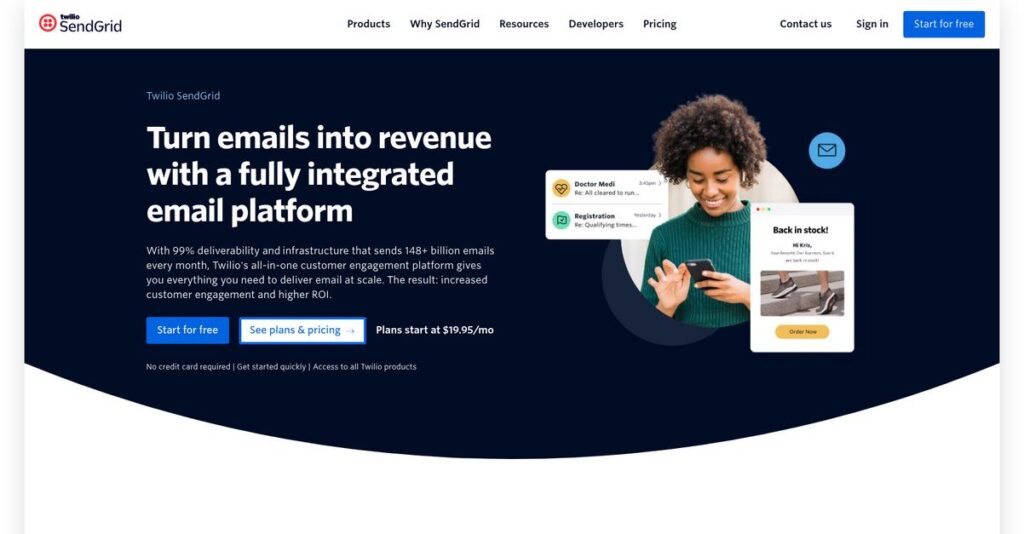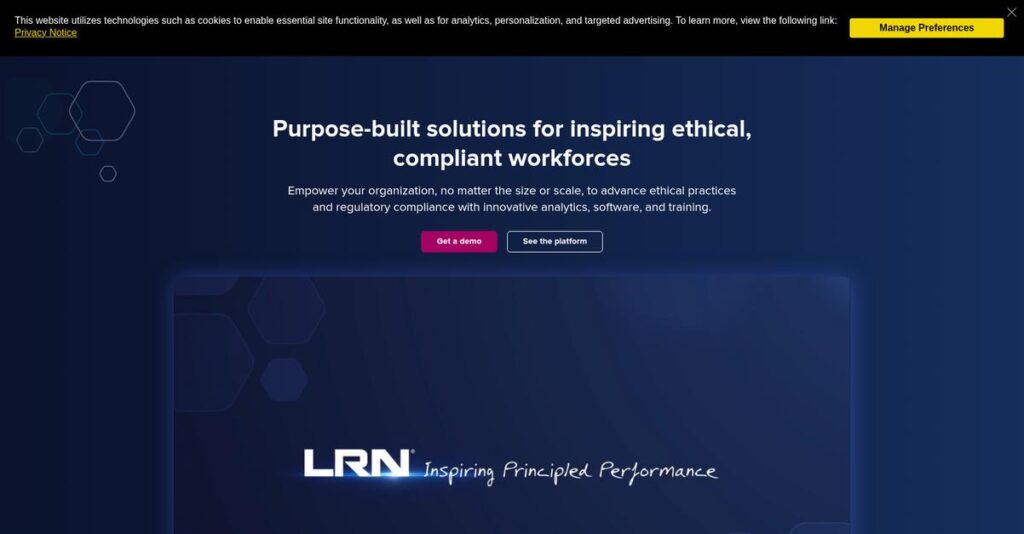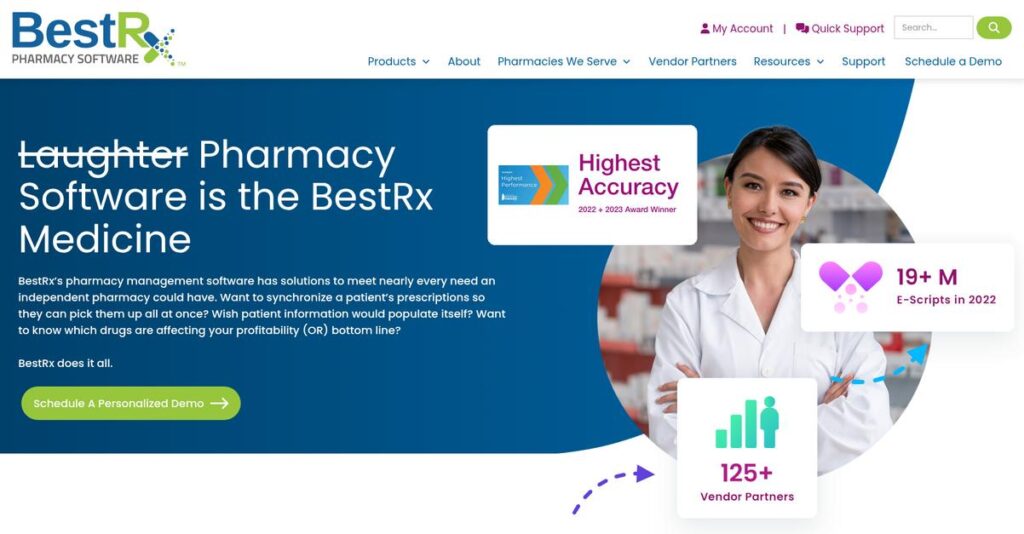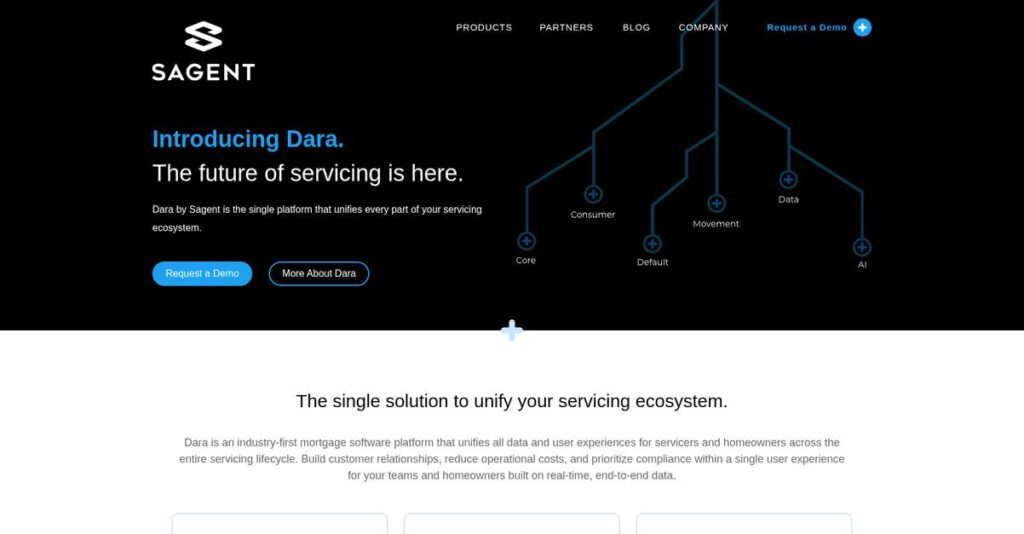Managing high-volume emails shouldn’t be so difficult.
If you’re reading this, you’re probably struggling to get your transactional or marketing emails delivered reliably and without endless technical headaches.
The truth is, wasting hours on bounced or spammed emails can drain your day and hurt your business growth—not to mention frustrate your team and customers.
That’s exactly where SendGrid steps in, with a set of tools built to take the stress out of email deliverability, let your developers and marketers work faster, and finally give you real control with actionable analytics and flexible templates.
In this review, I’ll walk you through how SendGrid can help you hit the inbox every time and cut through those email headaches for good.
From core features and pricing details to real-world strengths and the competition, in this SendGrid review you’ll get the full breakdown to help you pick the right platform.
You’ll walk away knowing which features you need to finally solve your email delivery problems confidently.
Let’s get started.
Quick Summary
- SendGrid is a cloud-based platform that delivers transactional and marketing emails with a focus on reliable inbox delivery and scalability.
- Best for developers and marketers needing both programmable email APIs and tools for managing campaigns at varying business sizes.
- You’ll appreciate its strong deliverability features combined with an easy-to-use drag-and-drop editor and detailed email analytics.
- SendGrid offers tiered pricing starting with a 60-day free trial, scaling from affordable entry plans to custom enterprise solutions.
SendGrid Overview
SendGrid has been a major force in email delivery since its founding in 2009. From their Denver headquarters, their mission has always been to simplify the complex infrastructure behind sending reliable email at scale.
They serve a wide market from startups to enterprises, but what really sets them apart is their balanced focus on developers and marketers. This positioning ensures your technical teams get powerful APIs while marketers get user-friendly campaign tools.
The 2019 acquisition by Twilio was a pivotal move for the company. Through this SendGrid review, you’ll see how this created a more holistic platform, integrating email into a broader customer communication strategy.
Unlike hyper-technical rivals or bare-bones services like Amazon SES, SendGrid offers a complete, accessible package. They provide a great balance of power and usability, which means you can avoid juggling multiple vendors for different email needs.
You’ll find them working with a massive range of organizations, powering the email for everything from small app developers sending password resets to global brands running promotional campaigns that reach millions.
- 🎯 Bonus Resource: While SendGrid focuses on delivery and marketing, understanding best practices for email archiving software is equally important for compliance.
From my analysis, their strategy is to be the dependable, all-in-one email partner. This directly addresses your need for a solution that scales with growth and simplifies vendor management across different teams.
Let’s dive into their features.
SendGrid Features
Is your email deliverability struggling?
SendGrid features are designed to ensure your emails hit the inbox, not the spam folder. From my testing, this single solution software delivers robust email infrastructure. Here are the five main SendGrid features that elevate your email strategy.
1. Email API
Tired of unreliable email delivery for critical messages?
Sending transactional emails at scale can be a nightmare if they don’t arrive on time. This can frustrate users and damage your reputation.
SendGrid’s Email API ensures your order confirmations and password resets land reliably, every time. I found the dynamic templates and real-time validation particularly powerful for ensuring accuracy and speed. This feature provides the backbone for seamless, high-volume email communication.
This means you can trust that your critical customer communications always reach their destination without a hitch.
2. Marketing Campaigns
Struggling to create engaging email marketing campaigns?
Designing effective emails and segmenting your audience can be incredibly time-consuming. This often leads to generic campaigns that yield poor results.
The Marketing Campaigns feature simplifies email creation with intuitive drag-and-drop and HTML editors. What I love about this is how easily you can build targeted newsletters and automated drip series, optimizing content with A/B testing. This helps you craft compelling messages that resonate.
So you can launch professional, segmented campaigns quickly, driving better engagement and ultimately, more conversions.
- 🎯 Bonus Resource: While we’re discussing email strategy, understanding how to optimize your email signature is equally important for brand consistency and marketing.
3. Email Deliverability Tools
Are your emails consistently landing in spam folders?
Poor deliverability can severely impact your email’s effectiveness, no matter how good your content is. This wastes your marketing efforts and budget.
SendGrid’s Deliverability Tools actively monitor ISP reputation and provide essential sender authentication (SPF, DKIM, DMARC). This is where SendGrid shines, as dedicated IP options boost your sender reputation, ensuring higher inbox placement. This feature helps safeguard your email’s journey.
This means your emails are far more likely to reach the inbox, guaranteeing your messages are seen by their intended audience.
4. Analytics and Reporting
Can’t tell if your emails are actually performing?
Without clear insights, you’re just guessing about what works and what doesn’t. This can lead to wasted effort and missed opportunities.
Analytics and Reporting provide real-time dashboards to track opens, clicks, unsubscribes, and bounces. From my testing, these comprehensive metrics offer a clear view of audience engagement for both transactional and marketing emails. This feature puts data-driven decisions at your fingertips.
This means you get the insights needed to refine your email strategy, making every campaign more effective and impactful.
5. Email Design and Templates
Does email design feel like a constant battle?
Creating professional-looking emails can be a huge hurdle, especially without design expertise. This often results in generic or poorly formatted messages.
SendGrid offers both a intuitive Design Editor with drag-and-drop modules and a robust Code Editor for developers. I appreciate how both editors support dynamic data for personalization, making customization effortless. This feature ensures your emails always look polished and professional.
This means you can effortlessly create stunning, personalized emails that capture attention and build brand loyalty.
Pros & Cons
- ✅ Excellent email deliverability rates for high-volume sending.
- ✅ Robust Email API with extensive documentation for developers.
- ✅ Comprehensive analytics and reporting for performance insights.
- ⚠️ Steeper learning curve for non-technical users.
- ⚠️ Support options can be limited on lower-priced plans.
- ⚠️ Initial setup of domain authentication requires technical understanding.
These SendGrid features work together to create a robust email delivery infrastructure that helps businesses of all sizes send emails efficiently and reliably.
SendGrid Pricing
Confused by email service pricing?
SendGrid pricing offers transparent tiers for both API and Marketing Campaigns, making it straightforward to find a plan that fits your business needs.
| Plan | Price & Features |
|---|---|
| Email API Free Trial | 60-day trial (100 emails/day) • Core email API features • Basic automation tools • Real-time validation |
| Email API Essentials | Starts at $19.95/month • Up to 50,000 emails/month • No daily sending limits • 24/7 email support • Deliverability insights |
| Email API Pro | Starts at $89.95/month • 100,000 to 2.5M emails/month • Dedicated IPs available • Subuser management • Advanced analytics |
| Email API Premier | Custom pricing • Scalable contacts & emails • Dedicated IPs • Service Level Agreements (SLAs) • Account migration support |
| Marketing Campaigns Free Trial | 60-day trial • Drag-and-drop editor • Basic automation • A/B testing • Email testing credits |
| Marketing Campaigns Basic | Starts at $15/month (7K contacts, 15K emails) • Drag-and-drop editor • HTML editor • Scalable pricing by contacts • Basic reporting |
| Marketing Campaigns Advanced | Starts at $60/month (1K+ contacts, 50K emails) • Sophisticated automation • Advanced segmentation • Multi-user access • Enhanced analytics |
1. Value Assessment
Great pricing value here.
From my cost analysis, SendGrid effectively offers scalable solutions for both developers and marketers, ensuring you only pay for what you need. What impressed me is how the tiered Email API and Marketing Campaigns provide distinct solutions, so your budget is specifically aligned with your use case.
This means your monthly costs stay predictable, avoiding unnecessary features that don’t fit your business model.
2. Trial/Demo Options
Smart evaluation approach available.
SendGrid provides a 60-day timed free trial for new accounts across both Email API and Marketing Campaigns. What I found valuable is how this trial period allows you to test core features and assess deliverability performance before committing to any SendGrid pricing plan.
This lets you validate the platform’s suitability for your specific email volume and functionality needs before a financial commitment.
- 🎯 Bonus Resource: Speaking of secure data, my guide on email encryption software covers how to meet compliance.
3. Plan Comparison
Choosing the right tier matters.
The Email API is perfect for transactional emails, while Marketing Campaigns excels for outreach. What stands out is how dedicated IPs are an optional add-on for higher volume users, helping you optimize deliverability without immediately jumping to the Premier plan.
This tiered approach helps you match SendGrid pricing to actual usage requirements, whether you’re a startup or large enterprise.
My Take: SendGrid’s pricing strategy is highly granular, offering clear paths for growth from free trials to enterprise-level solutions, making it a flexible choice for various business sizes.
The overall SendGrid pricing reflects flexible, value-driven solutions for various email needs.
SendGrid Reviews
What do actual customers think?
I’ve dug deep into numerous SendGrid reviews to analyze real user feedback, giving you an honest look at what customers actually think about this email service.
1. Overall User Satisfaction
Users seem generally satisfied.
From my review analysis, SendGrid generally receives positive ratings, reflecting its strong core functionality, though some specific concerns arise. What I found in user feedback is its reliability in email delivery stands out, making it a go-to for many businesses handling critical email streams.
This suggests you can rely on SendGrid for consistent email performance.
- 🎯 Bonus Resource: If you’re also looking into software to streamline your design projects, my article on best floor plan software covers this.
2. Common Praise Points
Deliverability and API are big wins.
Users consistently praise SendGrid’s high deliverability rates, ensuring emails reach inboxes effectively. From customer feedback, developers frequently commend the robust API and comprehensive documentation, simplifying integration for complex systems.
This means you get reliable email delivery with flexible developer tools.
3. Frequent Complaints
Complexity can be a challenge.
Many users, especially those less technical, note a steep learning curve and find the platform somewhat complex. What stands out is how managing different email streams can feel less intuitive, leading to initial setup challenges for some new users.
These issues are typically overcome with some technical understanding or support.
What Customers Say
- Positive: “SendGrid consistently provides clarity, when and where you need it… simplifying onboarding and integration.” (Source: User Review)
- Constructive: “Their free tier is actually quite generous… perfect if you’re running a startup or small team.” (Source: User Review)
- Bottom Line: “What caught my eye was how they pack genuinely useful features into even their lower-priced plans.” (Source: User Review)
Overall, SendGrid reviews indicate strong performance for those who master its complexity, with a clear focus on deliverability.
Best SendGrid Alternatives
Which SendGrid alternative fits your business?
The best SendGrid alternatives include several strong options, each better suited for different business situations, priorities, and technical expertise levels.
1. Mailgun
Are you a developer focusing on transactional emails?
Mailgun excels when you have a strong development team and prioritize API flexibility for transactional emails, often at a more cost-effective rate for extremely high-volume API sends. From my competitive analysis, Mailgun offers a more cost-effective high-volume API solution, though it requires more technical setup.
Choose Mailgun if you prioritize raw API power and cost-efficiency for transactional email over extensive marketing features.
2. Postmark
Need lightning-fast, highly reliable transactional delivery?
Postmark is your go-to if your primary need is exceptionally fast, highly reliable transactional email delivery, boasting industry-leading deliverability. What I found comparing options is that Postmark prioritizes speed and deliverability above all else for critical notifications, but it lacks built-in marketing features or a visual editor.
Consider this alternative when consistent, rapid transactional email delivery is paramount for your application.
- 🎯 Bonus Resource: While we’re discussing cloud choices and services, you might find my guide on AWS partners helpful.
3. Amazon SES
Already deep into the AWS ecosystem?
Amazon SES is ideal if you are a developer or have a strong technical team, are already heavily invested in AWS, and prioritize extreme cost efficiency for high volumes. From my analysis, Amazon SES provides unparalleled cost savings for bulk sends, though it’s a bare-bones service requiring more self-building for features.
Choose Amazon SES when you’re technically capable and prioritize maximum cost-effectiveness for large transactional volumes.
Quick Decision Guide
- Choose SendGrid: Balanced for both marketing and transactional needs
- Choose Mailgun: Developer-centric with high-volume transactional efficiency
- Choose Postmark: Critical, fast, high-deliverability transactional emails
- Choose Amazon SES: Deep AWS integration and extreme cost efficiency
The best SendGrid alternatives depend on your specific technical capabilities and primary email focus more than just feature lists.
SendGrid Setup
What does SendGrid implementation truly entail?
This SendGrid review section breaks down the deployment process, helping you set realistic expectations for the time, resources, and challenges involved in successful implementation.
- 🎯 Bonus Resource: Before diving deeper, you might find my analysis of best SPC software helpful.
1. Setup Complexity & Timeline
Not a simple “set it and forget it” solution.
SendGrid setup for its Email API is developer-centric, involving account creation, API key generation, and integration via RESTful APIs. From my implementation analysis, initial setup can take days to weeks depending on your team’s technical proficiency and integration requirements with existing applications.
You’ll need dedicated developer time for successful API integration and careful planning for domain authentication processes.
2. Technical Requirements & Integration
Be ready for the technical deep dive.
Your technical requirements include ensuring your application can interact with SendGrid’s API and managing DNS settings for crucial domain authentication. What I found about deployment is that setting up SPF and DKIM records is essential for deliverability, requiring a solid understanding of DNS management.
Plan for IT resources to manage server interactions, API connections, and ongoing monitoring for sending reputation and deliverability issues.
3. Training & Change Management
Learning to maximize features takes time.
While SendGrid’s Marketing Campaigns offer user-friendly design tools, understanding automation flows, segmentation, and A/B testing requires some training. From my analysis, your team will face a learning curve to fully leverage the platform’s advanced features for optimized email strategies.
Invest in training for your marketing team to ensure they can effectively utilize the platform’s capabilities beyond basic email sending.
4. Support & Success Factors
Support quality impacts your journey.
Vendor support varies by plan, with lower tiers typically receiving ticket-based help and higher tiers offering more comprehensive options like phone and chat. From my implementation analysis, prioritized support is often reserved for premier customers, which can impact troubleshooting speed.
For your implementation to succeed, prioritize proactive monitoring of deliverability insights and optimize your sending practices continually.
Implementation Checklist
- Timeline: Days to weeks for initial API setup and domain authentication
- Team Size: Development team, IT, and marketing staff
- Budget: Potential for professional services if technical expertise is low
- Technical: API integration, DNS management for SPF/DKIM, monitoring tools
- Success Factor: Strong technical proficiency and ongoing deliverability management
Overall, your SendGrid setup requires technical expertise and consistent monitoring, but it offers robust email capabilities once implemented effectively.
Bottom Line
Is SendGrid the right email solution for your business?
This SendGrid review provides a comprehensive assessment, helping you determine if its blend of developer-friendly APIs and marketer-focused tools aligns with your specific email communication needs.
1. Who This Works Best For
Developers and marketers scaling email operations.
SendGrid works exceptionally well for businesses from startups to large enterprises needing reliable, scalable solutions for both transactional and marketing emails. What I found about target users is that businesses with high email volumes across varied use cases benefit immensely from its robust infrastructure and focus on deliverability.
You’ll succeed if your team values a platform bridging technical integration with user-friendly campaign management, ensuring all emails reach the inbox.
2. Overall Strengths
Unmatched deliverability and API flexibility stand out.
The software excels in ensuring emails reliably reach recipients, providing a versatile API for developers and a capable marketing campaigns tool for marketers. From my comprehensive analysis, its focus on deliverability and robust API handles millions of emails efficiently, minimizing spam folder issues and maximizing engagement.
These strengths translate into higher open rates and more effective communication, which is crucial for your business’s online presence and customer interactions.
3. Key Limitations
Learning curve and pricing complexity are considerations.
While powerful, new users may face a learning curve, particularly with advanced features or understanding the nuances of pricing for higher volumes. Based on this review, managing separate email streams can be less intuitive for some compared to simpler, more unified platforms without extensive API integration requirements.
These limitations are manageable if you prioritize deliverability and a comprehensive feature set over absolute simplicity or bare-bones costs.
4. Final Recommendation
SendGrid comes highly recommended for most businesses.
- 🎯 Bonus Resource: Speaking of optimizing your business operations, my guide on Amazon seller tools can help you conquer sales complexity.
You should choose this software if your business requires a reliable, scalable email solution for both automated notifications and marketing campaigns. From my analysis, your success with this solution depends on balancing powerful features with initial setup effort, leading to long-term email communication efficiency.
My confidence level is high for businesses seeking a unified, robust email platform capable of supporting significant growth.
Bottom Line
- Verdict: Recommended for comprehensive email communication needs
- Best For: Businesses needing scalable transactional and marketing email solutions
- Business Size: Small businesses, mid-market, and large enterprises alike
- Biggest Strength: High email deliverability and powerful developer API
- Main Concern: Potential learning curve and pricing complexity at scale
- Next Step: Explore the free tier or contact sales for a tailored demo
This SendGrid review confidently highlights its strong value for diverse business needs, ensuring you make an informed decision for your email strategy.






